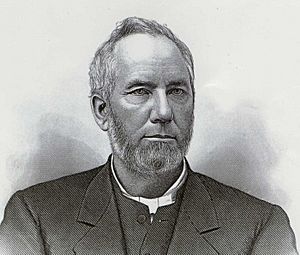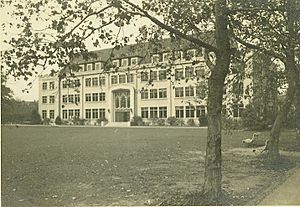Holland Nimmons McTyeire facts for kids
Quick facts for kids
Holland Nimmons McTyeire
|
|
|---|---|
 |
|
| Born | July 28, 1824 |
| Died | February 15, 1889 (aged 64) Nashville, Tennessee, U.S.
|
| Alma mater | Randolph-Macon College |
| Occupation | Preacher, educator |
| Spouse(s) | Amelia Townsend |
| Relatives | John James Tigert III (son-in-law) John J. Tigert (grandson) |
| Signature | |
Holland Nimmons McTyeire (born July 28, 1824 – died February 15, 1889) was an important American bishop in the Methodist Episcopal Church, South. He was chosen as a bishop in 1866. He also helped start Vanderbilt University in Nashville, Tennessee. McTyeire held beliefs that supported the practice of slavery in the United States.
Contents
Early Life and Education
Holland McTyeire was born on July 28, 1824. His birthplace was Barnwell County, South Carolina. His parents, John and Elizabeth McTyeire, were members of the Methodist Episcopal Church, South. His father was a cotton farmer and owned enslaved people.
McTyeire went to several schools. He studied at Cokesbury, South Carolina, and then at Collinsworth Institute in Georgia. In 1844, he earned his Bachelor of Arts degree from Randolph-Macon College in Virginia.
Career as a Preacher and Editor
McTyeire was allowed to preach in November 1845. He joined the Virginia Annual Conference. His first job was in Williamsburg, Virginia. After a year, he moved to the Alabama Conference.
He served as a pastor in Alabama, in cities like Mobile and Demopolis. He also worked in Columbus, Mississippi. Later, he moved to the Louisiana Conference. There, he became an elder in 1849. He also served as a pastor in New Orleans.
In 1854, McTyeire became the editor of the New Orleans Christian Advocate. He worked there until 1858. After that, he became the editor of the Nashville Christian Advocate. This was a main newspaper for the M.E. Church, South.
The American Civil War (1861-1865) interrupted his work as an editor. He returned to being a pastor in Montgomery, Alabama. In 1866, he was elected as a bishop at a big meeting in New Orleans.
Founding Vanderbilt University
Bishop McTyeire wanted to create a top-level learning institution. In 1872, he and others received a charter for a "Central University." This university was meant for the nine Methodist Episcopal Church, South Annual Conferences in the mid-south. However, they did not have enough money to build it.
In 1873, McTyeire went to New York City for medical help. His wife, Amelia Townsend, was a cousin to Cornelius Vanderbilt's second wife. This family connection was very important. Commodore Vanderbilt gave McTyeire two large gifts of $500,000 each. McTyeire used this money to start Vanderbilt University.
Commodore Vanderbilt's gift came with a special condition. McTyeire had to be the chairman of the university's Board of Trust for his entire life. In 1873, McTyeire was also named President of Vanderbilt University.
McTyeire also appointed Fountain E. Pitts, a veteran of the Confederate army, as the first pastor of the McKendree Church. This church later became known as the West End United Methodist Church.
Views on Slavery
Holland McTyeire believed that slavery was a natural part of human society. In 1859, he wrote a book called Duties of Christian Masters. In this book, he wrote that he believed slavery was a punishment from God. He also stated that he felt it was his duty as a religious person to make sure slavery continued.
Personal Life
Holland McTyeire was married to Amelia Townsend. She was from Mobile, Alabama.
Death and Legacy
Holland McTyeire passed away on February 15, 1889, in Nashville, Tennessee. A portrait of him, painted by Jared Bradley Flagg, used to hang in Main Hall (now Kirkland Hall) at Vanderbilt. Sadly, it was destroyed in a fire in 1905. Another portrait, painted by Ella Sophonisba Hergesheimer in 1907, can be seen in Kirkland Hall today.
In the 1940s, the first dormitory for women at Vanderbilt was named McTyeire Hall. It is now called McTyeire International House. The McTyeire School for Girls in Shanghai, China, is also named after him. This school was started by Young John Allen and Laura Askew Haygood.
See also
- List of bishops of the United Methodist Church


